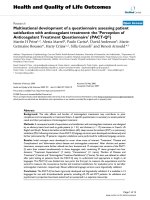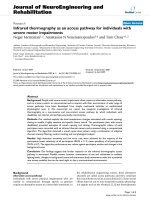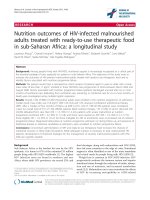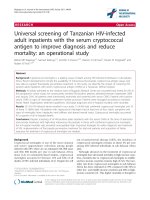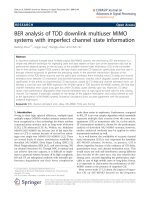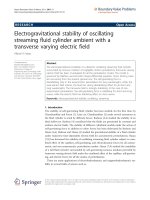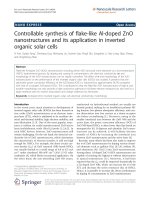Báo cáo hóa học: " Template Synthesis of Three-Dimensional Cubic Ordered Mesoporous Carbon With Tunable Pore Sizes" docx
Bạn đang xem bản rút gọn của tài liệu. Xem và tải ngay bản đầy đủ của tài liệu tại đây (305.3 KB, 5 trang )
NANO EXPRESS
Template Synthesis of Three-Dimensional Cubic Ordered
Mesoporous Carbon With Tunable Pore Sizes
Weijie Dai
•
Mingbo Zheng
•
Yu Zhao
•
Shutian Liao
•
Guangbin Ji
•
Jieming Cao
Received: 30 July 2009 / Accepted: 24 September 2009 /Published online: 14 October 2009
Ó to the authors 2009
Abstract Three-dimensional cubic ordered mesoporous
carbons with tunable pore sizes have been synthesized by
using cubic Ia3d mesoporous KIT-6 silica as the hard
template and boric acid as the pore expanding agent. The
prepared ordered mesoporous carbons were characterized
by powder X-ray diffraction, scanning electron micros-
copy, transmission electron microscopy, and nitrogen
adsorption–desorption analysis. The results show that the
pore sizes of the prepared ordered mesoporous carbons
with three-dimensional cubic structure can be regulated in
the range of 3.9–9.4 nm. A simplified model was proposed
to analyze the tailored pore sizes of the prepared ordered
mesoporous carbons on the basis of the structural param-
eters of the silica template.
Keywords Template synthesis Á Mesoporous carbon Á
Mesoporous silica Á Pore size control Á KIT-6
Introduction
In recent years, ordered mesoporous carbons (OMCs) with
uniform pore sizes, high surface areas, and large pore
volumes have been of wide interest for applications in
many fields, such as catalyst supports, adsorbents, fuel
cells, and electrodes for supercapacitors [1–3]. The hard
template method has been successfully developed in the
synthesis of OMCs. Since the emergence of numerous
mesoporous silica materials, OMCs with various pore
structures and narrow pore size distributions have been
achieved by replicating the structures of mesoporous silica
materials. The first OMC, CMK-1, was synthesized by
Ryoo et al. [4] using MCM-48 silica (Ia3d) as a hard
template. After that, ordered mesoporous silica materials
with diverse symmetries, such as SBA-15 (p6mm)[5, 6],
SBA-16 (Im3m)[6], KIT-6 (Ia3d)[7, 8], and FDU-12
(Fm3m)[9], were also employed to prepare OMCs.
The hard template synthesis procedure of OMCs
involves impregnation of the silica template, carbonization
of the carbon precursor, and removal of the silica template
[1]. The structure of the OMC, such as the pore shape and
the pore size, was determined by the silica template. It is
believed that OMCs with tunable pore size distributions
would be beneficial for various applications. Ryoo et al.
reported the synthesis of mesoporous silicas with control-
lable pore wall thicknesses of 1.4–2.2 nm, which were
further used as templates to synthesize OMCs with tailored
pore diameters of 2.2–3.3 nm [10]. Alvarez et al. [11]
modulated the pore sizes of mesoporous carbons within the
range of 2–10 nm by changing the synthesis temperature of
the silica template. However, the synthesis procedures of
silica templates with different properties were tedious and
difficult to precisely control.
Recently, Lee et al. [12] reported the synthesis of two-
dimensional (2-D) hexagonal OMCs with controllable pore
sizes in the range of 3–10 nm using MSU-H silica as the
hard template and boric acid as the pore expanding agent,
which was considered to be a facile method for the pore
size control of OMCs. The pore expansion was realized by
W. Dai Á M. Zheng Á Y. Zhao Á S. Liao Á G. Ji Á J. Cao (&)
Nanomaterials Research Institute, College of Materials Science
and Technology, Nanjing University of Aeronautics and
Astronautics, 210016 Nanjing, People’s Republic of China
e-mail:
Y. Zhao
Key Laboratory of Mesoscopic Chemistry of MOE and Jiangsu
Provincial Laboratory for Nano Technology, Department
of Chemistry, Nanjing University, 210093 Nanjing,
People’s Republic of China
123
Nanoscale Res Lett (2010) 5:103–107
DOI 10.1007/s11671-009-9450-3
the spontaneous phase separation of the boron species from
the boron and carbon precursors to the silica surface.
Besides, the pore size was determined by the amount of the
boric acid added to the carbon precursor. Herein, on the
basis of this method, we report the synthesis of three-
dimensional (3-D) cubic OMCs with tunable pore size
distributions using KIT-6 silica as the template and boric
acid as the pore expanding agent. Compared with MSU-H
silica, KIT-6 silica exhibits 3-D cubic structure with Ia3d
symmetry, which consists of the interpenetrating bicon-
tinuous channel networks. We demonstrated that the
aforementioned synthesis pathway could be generalized to
prepare OMCs with various structures and symmetries
using different mesoporous silicas as templates. Moreover,
we quantitatively analyzed the pore expansion mechanism
using a simplified model on the basis of structural param-
eters of the silica template.
Experimental Section
Chemicals
The poly(alkylene oxide)-based triblock copolymer Plu-
ronic P123 (EO
20
PO
70
EO
20
,MW= 5,800) and tetraethyl
orthosilicate (TEOS, 98 wt%) were purchased from
Aldrich Chemical Inc. Other chemicals were purchased
from Shanghai Chemical Corp. All chemicals were used as
received without further purification.
Synthesis of KIT-6 Silica
The synthesis of mesoporous KIT-6 silica with cubic Ia3d
symmetry was performed according to the literature pro-
cedure reported elsewhere [8]. Typically, 5 g of Pluronic
P123 was dissolved in 180 g of distilled water and 9.9 g of
HCl solution (35 wt%) under vigorous stirring at 35°C.
After complete dissolution, 5 g of n-butanol (99.4 wt%)
was added. Following further stirring for 1 h, 10.75 g of
TEOS was added immediately. Subsequently the mixture
was left stirring at 35°C for 24 h and transferred into an
autoclave, which was sealed and maintained at 100°C for
another 24 h under static conditions. The resulting solid
product was filtered and dried at 100°C overnight. After a
brief ethanol/HCl washing, the final sample was dried at
70°C and calcined at 550°C for 6 h in air.
Synthesis of Ordered Mesoporous Carbons
Ordered mesoporous carbon materials were synthesized
using the recipe described previously [4, 12]. KIT-6 and
sucrose were used as the template and the carbon precursor,
respectively. Various amount of boric acid were added to
the carbon precursor while keeping the sucrose concen-
tration constant. The carbon replicas were designated as
OMC-x, where x stands for the molar ratio of boric acid to
sucrose. In a typical synthesis of OMC-1, 0.113 g of boric
acid (99.5 wt%), 0.625 g of sucrose (95 wt%), and 0.071 g
of sulfuric acid (98 wt%) were dissolved in 2.5 g of dis-
tilled water. After 0.5 g of KIT-6 silica was added, the
mixture was heated at 100°C for 6 h, and subsequently at
160°C for another 6 h. The resulted composite was
impregnated again with an aqueous solution consisting of
0.075 g of boric acid, 0.413 g of sucrose, 0.047 g of sul-
furic acid, and 2.5 g of distilled water. After the heat
treatment at 100°C and 160°C once again as before, the
composite was carbonized at 900°C for 3 h under N
2
flow.
Finally, the OMC-1 material was obtained by the removal
of the silica template using 5 wt% HF solution at room
temperature.
Characterization
Low-angle X-ray diffraction (XRD) was carried out on a
Bruker D8 advance X-ray diffractometer using Cu Ka
radiation. Scanning electron microscopy (SEM) images
were obtained with a Hitachi S-4800 scanning electron
microscope operating at 10 kV. Transmission electron
microscopy (TEM) images were taken on a JEOL JEM-
2100 microscope operated at 200 kV. Nitrogen adsorption–
desorption isotherms were measured on a Micromeritics
ASAP 2010 volumetric adsorption analyzer at 77 K.
Results and Discussion
Figure 1 illustrates the XRD patterns of the KIT-6 silica
and the carbons with tailored pore sizes. The KIT-6 silica
exhibits well-resolved hkl reflections, which is character-
istic of highly ordered 3-D cubic Ia3d symmetry. The
OMCs with different pore sizes also exhibit cubic struc-
ture, which is similar to that of the KIT-6 silica template.
Moreover, the d
211
spacings of all OMC samples only
varied slightly when the molar ratio of boric acid to
sucrose was increased from 0 to 12. Figure 2 shows SEM
and TEM images of KIT-6 and OMC-4. As can be seen in
the Fig. 2a and b, the morphology of the OMC-4 is close
to that of the mesoporous silica template. The cubic
structures of the silica and carbon products were further
demonstrated by the representative TEM images of KIT-6
and OMC-4 shown in Fig. 2c and d, respectively.
N
2
adsorption–desorption isotherms and the corre-
sponding pore size distributions determined from the
adsorption branches for KIT-6 silica and the OMCs are
shown in Fig. 3. All samples represent type IV iso-
therms with a sharp capillary condensation step, which is
104 Nanoscale Res Lett (2010) 5:103–107
123
indicative of a uniformity of mesopore size. For the
OMC-0 replica of KIT-6 with no boron content in the
carbon precursor, the capillary condensation step occurs
at a relative pressure of about 0.4, which is consistent
with the results reported elsewhere [13–15]. As the boron
content increases, the position of the step gradually shifts
to higher relative pressures, which reflects the effect of
the boric acid on the pore size control. The systematic
increase of the mesopore size with increasing the boron
content in the carbon precursor was further confirmed by
the pore size distribution curves of the prepared OMCs
shown in Fig. 3b. All carbon replicas exhibit narrow pore
size distributions except OMC-12, which has some dete-
rioration of the mesostructure as convinced by the XRD
pattern in Fig. 1. The structural properties of KIT-6 silica
and the OMCs are summarized in Table 1. The prepared
OMCs with tailored pore sizes possess the pore diameters
of 3.9–9.4 nm.
We proposed a simplified model to quantitatively ana-
lyze the pore expansion of the as-synthesized OMCs.
Figure 4 illustrates the schematic drawing of the pore
expansion model for the synthesis of the OMC with tai-
lored pore size. The d
0
and a
0
is the pore diameter and unit
cell parameter of KIT-6 silica, respectively, and the w
0
is
the wall thickness of KIT-6 silica, which is equal to
a
0
/2 - d
0
. It is assumed that the boric acid and the sucrose
are separated after the co-infiltration of the boric acid
together with the sucrose, although the spontaneous phase
separation of the boron species will occur during the
Fig. 1 XRD patterns of KIT-6 silica and the OMCs
Fig. 2 SEM images of a KIT-6 and b OMC-4. TEM images of
c KIT-6 and d OMC-4
Nanoscale Res Lett (2010) 5:103–107 105
123
carbonization process [12]. On the assumption that x is the
molar ratio of boric acid to sucrose, according to the
relationship between the volume ratio and the molar ratio,
we can deduce that the d
1
is equal to (1 ? 0.2x)
-3
d
0
, and
then the distance w
1
is equal to w
0
? d
0
- d
1
. In the
synthesis of the OMC using the sucrose as the carbon
precursor, the shrinkage of the carbon structure during the
carbonization process was evidenced by the data reported
elsewhere and the percentage of shrinkage of the structure
g was estimated to be 10–15% [12, 13]. Thus, the diameter
of the carbon rod d
2
is estimated to be (1 - g)d
1
after the
carbonization process, and the pore diameter of OMC-x
with tailored pore size is expressed as:
w
OMCÀx
¼ w
0
þ½1 Àð1 ÀgÞ 1 þ0:2xðÞ
À3
d
0
ð1Þ
According to the Eq. 1, the pore diameters of OMC-1,
OMC-4, OMC-8, and OMC-12 are estimated to be 4.85–
5.2, 5.65–5.96, 6.3–6.57, 6.71–6.96 nm, respectively. The
estimated values are mainly coincident with the data shown
in Table 1 except for OMC-12, which exhibits a greatly
Fig. 3 a N
2
adsorption–
desorption isotherms for KIT-6
silica and the OMCs. The
sorption isotherms for the
OMC-0, OMC-1, OMC-4,
OMC-8, and OMC-12 have
been shifted vertically by 50,
550, 750, 1,200, and 1,450 cm
3
/
g, respectively. b The
corresponding pore size
distributions for KIT-6 silica
and the OMCs calculated from
adsorption branches using the
BJH algorithm
Table 1 Structural properties of KIT-6 silica and the OMCs
Samples a
0
(nm) d
0
(nm) S
BET
(m
2
/g) S
micro
(m
2
/g) V
tot
(cm
3
/g) V
micro
(cm
3
/g)
KIT-6 22.4 7.5 790.2 105.4 1.11 –
OMC-0 19.9 3.9 1,188.3 217.9 1.33 0.10
OMC-1 19.4 4.9 692.7 200.1 0.98 0.09
OMC-4 19.4 5.7 955.8 435.6 1.32 0.21
OMC-8 20.1 6.6 779.2 404.2 1.27 0.19
OMC-12 20.1 9.4 1,017.9 550.5 1.68 0.27
XRD unit-cell parameter a
0
is equal to 6
1/2
d
211
; d
0
is the pore diameter calculated from the adsorption branch of the isotherm using the BJH
method; S
BET
is the specific surface area using the BET method; S
micro
is the micropore surface area; V
tot
is the total pore volume at relative
pressure of 0.99; V
micro
is the micropore volume
Fig. 4 Schematic drawing of
the simplified pore expansion
model for the synthesis of the
OMC with tailored pore size.
1 Co-infiltration of boric acid
and sucrose. 2 Carbonization
and removal of the silica
template. The pore
interconnectivity existed in the
silica and the carbon replica is
not shown
106 Nanoscale Res Lett (2010) 5:103–107
123
broader pore size distribution due to the structural
deterioration.
On the basis of the unit cell parameter and the pore
diameter of KIT-6 silica, we estimated the pore diameter of
the prepared OMC. OMCs with more precisely controlled
pore sizes can be synthesized according to the estimated
values calculated from the Eq. 1 with proper molar ratio of
boric acid to sucrose. It should be noted that the afore-
mentioned derivation is simplified. The practical volume
changes during the carbonization and the spontaneous
phase separation of the boron species were neglected.
Moreover, the pore size analysis performed using the BJH
method is applicable for cylindrical mesopores [16, 17],
whereas the inverse carbon replica of KIT-6 exhibits rod-
type structure [7]. It results in the overestimation of the
pore widths of the prepared OMCs, which was also ignored
in the derivation.
Conclusions
In summary, we synthesized 3-D cubic OMCs with tunable
pore sizes in the range of 3.9–9.4 nm by using KIT-6 silica
as the hard template and boric acid as the pore expanding
agent. The pore expansion method reported by Lee et al.
was demonstrated to be effective on the preparation of
OMCs with different pore symmetries and tunable pore
sizes. According to a simplified model, we deduced the
carbon pore size equation that is expected to direct the
synthesis of OMCs with tunable pore sizes on the basis of
this synthesis pathway. The present work is expected to be
helpful for the synthesis of OMCs with other pore struc-
tures by using other kinds of silica templates. Further, the
practical application of the prepared 3-D cubic OMCs in
energy storage is under investigation and will be reported
in the future.
Acknowledgments This work was supported by National Science
Foundation of Jiangsu Province (BK2006195), Doctor Innovation
Funds of Jiangsu Province (BCXJ06-13), and National Natural Sci-
ence Foundation of China (50502020, 50701024).
References
1. C.D. Liang, Z.J. Li, S. Dai, Angew. Chem. Int. Ed. 47, 3696 (2008)
2. J. Lee, J. Kim, T. Hyeon, Adv. Mater. 18, 2073 (2006)
3. A. Stein, Z.Y. Wang, M.A. Fierke, Adv. Mater. 21, 265 (2009)
4. R. Ryoo, S.H. Joo, S. Jun, J. Phys. Chem. B 103, 7743 (1999)
5. D.Y. Zhao, J.L. Feng, Q.S. Huo, N. Melosh, G.H. Fredrickson,
B.F. Chmelka, G.D. Stucky, Science 279, 548 (1998)
6. D.Y. Zhao, Q.S. Huo, J.L. Feng, B.F. Chmelka, G.D. Stucky, J.
Am. Chem. Soc. 120, 6024 (1998)
7. F. Kleitz, S.H. Choi, R. Ryoo, Chem. Commun. 17, 2136 (2003)
8. T.W. Kim, F. Kleitz, B. Paul, R. Ryoo, J. Am. Chem. Soc. 127,
7601 (2005)
9. J. Fan, C.Z. Yu, T. Gao, J. Lei, B.Z. Tian, L.M. Wang, Q. Luo, B.
Tu, W.Z. Zhou, D.Y. Zhao, Angew. Chem. Int. Ed. 42, 3146
(2003)
10. J.S. Lee, S.H. Joo, R. Ryoo, J. Am. Chem. Soc. 124, 1156 (2002)
11. S. Alvarez, A.B. Fuertes, Carbon 42, 433 (2004)
12. H.I. Lee, J.H. Kim, D.J. You, J.E. Lee, J.M. Kim, W.S. Ahn, C.
Pak, S.H. Joo, H. Chang, D.Y. Seung, Adv. Mater. 20, 757 (2008)
13. K.P. Gierszal, T.W. Kim, R. Ryoo, M. Jaroniec, J. Phys. Chem. B
109, 23263 (2005)
14. K.P. Gierszal, M. Jaroniec, T.W. Kim, J. Kim, R. Ryoo, New J.
Chem. 32, 981 (2008)
15. T.W. Kim, L.A. Solovyov, J. Mater. Chem. 16, 1445 (2006)
16. M. Kruk, M. Jaroniec, A. Sayari, Langmuir 13, 6267 (1997)
17. T.W. Kim, R. Ryoo, K.P. Gierszal, M. Jaroniec, L.A. Solovyov,
Y. Sakamoto, O.J. Terasaki, J. Mater. Chem. 15, 1560 (2005)
Nanoscale Res Lett (2010) 5:103–107 107
123
